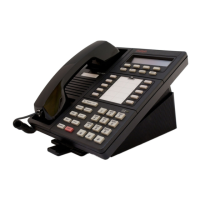MERLIN LEGEND Communications System Release 6.1
Feature Reference
555-661-110
Issue 1
August 1998
Features
Page 185Coverage
Ringing Options Calls received on line buttons programmed for No Ring are not sent to
coverage.
Primary Cover, Secondary Cover, and Group Cover buttons can be
programmed for Immediate Ring, Delay Ring, or No Ring. If an Individual
or Group Coverage receiver is on a call when a coverage call is received,
the receiver hears an abbreviated ring (if abbreviated ringing is enabled).
Calls received on a Primary Cover, Secondary Cover, or Group Cover
button ring with the receiver’s (not the sender’s) personalized ringing
pattern.
In Release 4.1 and later systems, the ringing at a programmed Primary or
Secondary Cover button, set for Delay Ring, is controlled by the Primary
or Secondary Ring Delays set for the sender’s extension. The
systemwide Secondary Ring Delay Interval (fixed at two rings) also
augments ringing on Secondary Cover buttons set for Delay Ring. For
more information, see Figure 6 on page 167
and Figure 8 on page 169.
Service Observing In Release 6.1 and later systems calls that arrive on Primary or
Secondary Coverage buttons can be observed.
Calls that arrive on Group Coverage buttons can be observed.
Calls that go to Group Calling Coverage and are answered by a calling
group agent can be observed.
Integrated or Generic VMI ports cannot be members of Service Observing
groups; a call sent to one of these ports cannot be observed.
SMDR The extension number answering an Individual or Group Coverage call is
shown on the SMDR report.
In Release 4.2 and later systems, when an Auto Login or Auto Logout
calling group is programmed as a Group Coverage receiver and the
SMDR Talk Time option is enabled, calls are reported following the same
rules that apply to other incoming calling group calls. This is true even if a
call is transferred from an operator to a Group Coverage sender before
being directed to the calling group.
System Access/
Intercom Buttons
A covered call remains on the sender’s SA or ICOM button until it is
answered at the receiver’s telephone.
A call received on a Shared SA button is not eligible for any coverage.
If a receiver programs a Primary Cover, Secondary Cover, or Group
Cover button for a sender and also has an SSA button associated with
the sender, the green LEDs next to both the Cover button and the Shared
SA button flash. The red LED stays on at the Shared SA button, but does
not go on at the Cover button.

